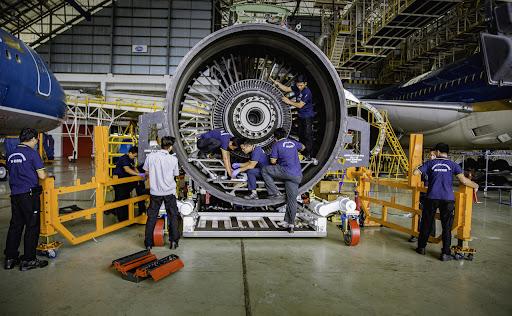
Aviation offers the best prospects for U.S. companies to do business in Vietnam, according to a recent U.S. International Trade Administration report written by Anh Nguyen, a commercial specialist with the U.S. Commercial Service at the U.S. Embassy in Hanoi and Nga Hoang, a commercial specialist at the U.S. Consulate in Ho Chi Minh City. The two analysts see opportunities with rapidly growing Vietnamese airlines, airports and air traffic management.
They see especially significant opportunities in the MRO sector, which is small now and which the government wants to see grow much larger. However, there are special competitive challenges for U.S. companies.
Before 2020, Vietnam was the world’s seventh- fastest growing aviation market with average annual growth of 16% in passengers and 14% in cargo. In 2020, the pandemic caused a more than $4 billion decrease in revenue for Vietnam’s aviation industry and its first negative growth rate. Nevertheless, Vietnam’s airports handled 66 million passengers in 2020.
The Civil Aviation Administration of Vietnam (CAAV) projects that passengers will increase about 8% annually in the coming decade, to 280 million per year by 2030, with aircraft capacity at 308 million passengers per year.
CAAV expects that Vietnamese fleets will thus grow faster than traffic, at nearly 10% annually, and MRO demand will grow even faster, at 11% annually as young fleets age. Domestic MRO should grow even faster. Vietnam’s domestic MRO capability is still in the initial stages—a bit like China’s 20-25 years ago—and accounts for only a quarter of the MRO market. As traffic and fleets increase, growth will provide the scale to do more MRO locally. By 2030, CAAV estimates Vietnam’s overall MRO demand will total $7.4 billion, a third of U.S. demand not so long ago.
CAAV hopes domestic resources will play a much bigger role in satisfying that demand. At present, the country’s MRO capabilities are provided by a few main players.
Vietnam Airlines Engineering Company (VAECO) is a subsidiary of Vietnam Airlines. In June 2019, Singapore Technologies Engineering and VAECO established a joint venture to repair components. Vietstar Aero Engineering Company (VSAE) is similarly a subsidiary of Vietstar Airlines. Southern Airport Aircraft Maintenance Services, a joint venture of SIA Engineering Company and Southern Airports Corporation, provides line maintenance at Ho Chi Minh City’s Tan Son Nhat Airport, Vietnam’s busiest airport. Aerospace Engineering Service does component maintenance, while Pacific Airlines, Vietjet and Bamboo Airways confine themselves to managing the continued airworthiness of their fleets, outsourcing actual maintenance.
“Given the extensive infrastructure development, construction of new airports, the rapid growth rate of the aviation market in the next ten years and the high rate of MRO services being outsourced, the MRO market in Vietnam is certainly one of the most promising markets in the region and in the world,” claim Nguyen and Hoang in their report.
Moreover, the CAAV is now encouraging domestic companies to cooperate with foreign investors to enhance the country’s MRO capacity at Noi Bai, Tan Son Nhat, Da Nang, Chu Lai, Cam Ranh, Phu Quoc and Can Tho airports.
However, there are still challenges for MRO development in Vietnam due to a shortage of a skilled workers, few hangars, lack of a material distribution hub and a weak supporting industry for MRO.
Nguyen and Hoang say that U.S. companies are highly respected in Vietnam as the world’s leading aviation equipment manufacturers and service providers, known for advanced technologies, quality and professionalism. They believe the chief opportunities for U.S. companies in Vietnamese aviation development include architecture, engineering and construction management, consulting and—in maintenance—training services.
U.S. MROs also face some special challenges in this market. U.S. firms bidding on infrastructure projects are often competing with companies backed by their government, for instance, by Japanese official development assistance. In addition, “. . . U.S. companies are late in returning to the market compared with EU, Japanese and Korean competitors,” say Nguyen and Hoang.
Further, the recovery of the aviation industry from COVID-19 is unpredictable, which slows new investment and expansion. Finally, say the analysts, “Lack of transparency in tender information and tender evaluation is also challenging for new entrants.”

